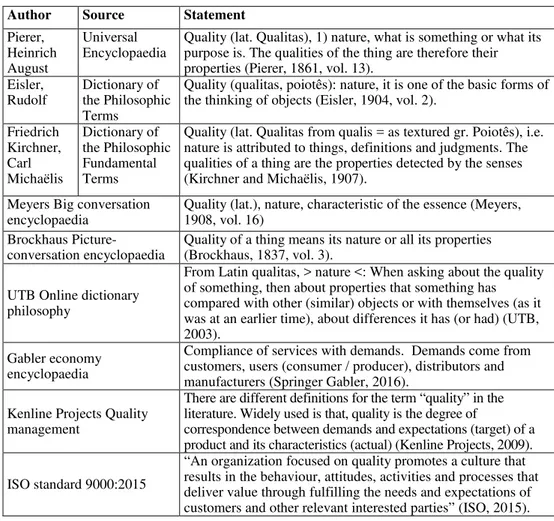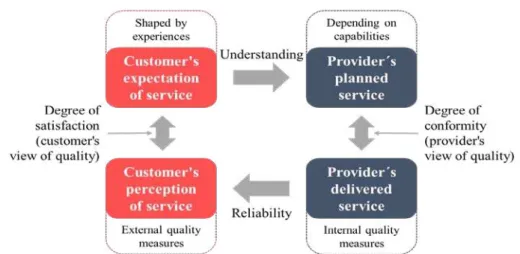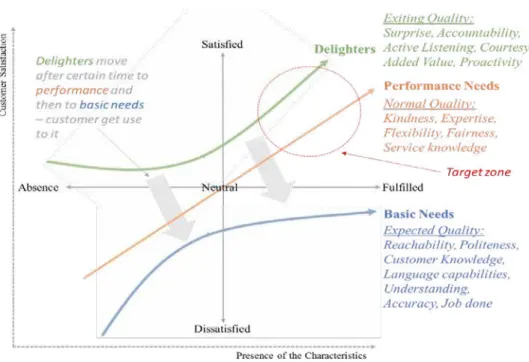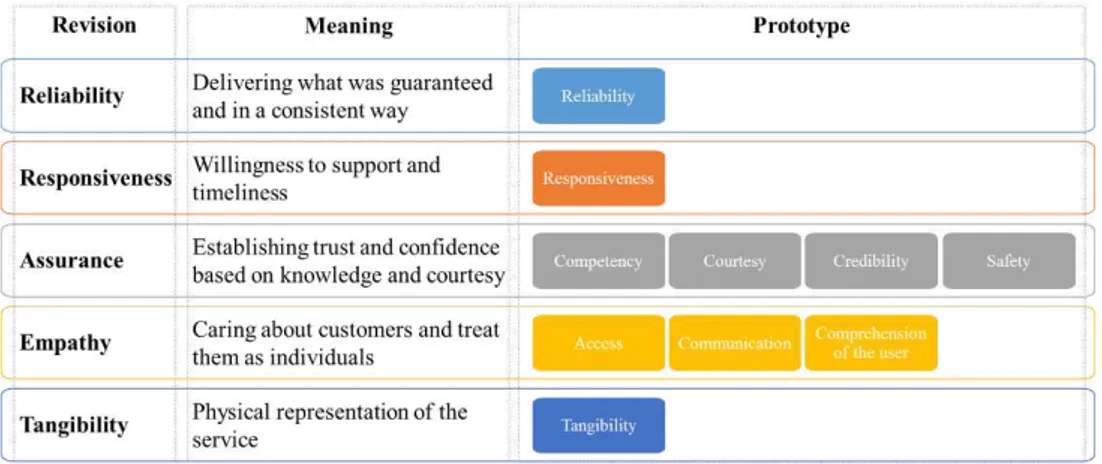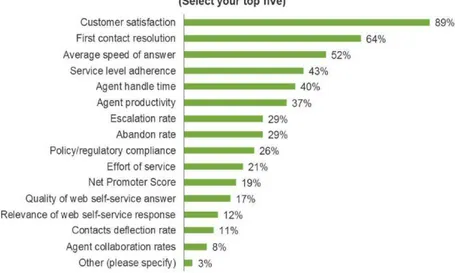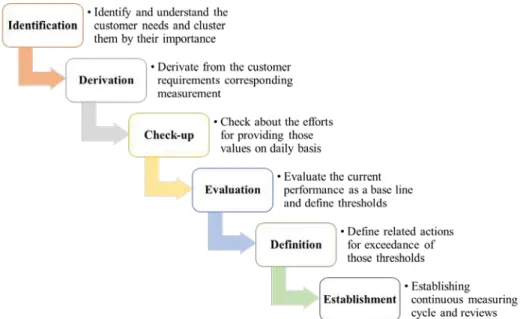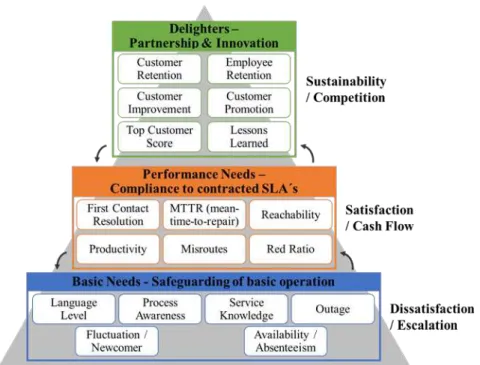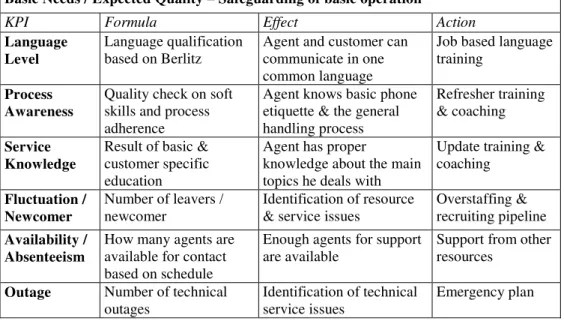STUDY ON THE DEVELOPMENT OF QUALITY MEASUREMENTS MODELS
FOR STEERING BUSINESS SERVICES
IN RELATION TO CUSTOMER SATISFACTION
Katrin Marquardt
1*,
Marieta Olaru
2and Ioana Ceausu
31),2),3)
The Bucharest University of Economic Studies, Romania
Please cite this article as:
Marquardt, K., Olaru, M. and Ceausu, I., 2017. Study on the Development of Quality Measurements Models for Steering Business Services in Relation to Customer Satisfaction. Amfiteatru Economic, 19(44), pp. 95-109
Article History
Received: 30 September 2016 Revised: 20 November 2016 Accepted:16 December 2016
Abstract
The growing competition in the market, higher customer demands and globalisation forces the business service providers to improve their services much faster. Nowadays, it is not enough to provide good quality it is more important to delight the customers and to deliver more than they expect. Likewise, renowned research companies predicted that customer satisfaction will become the competitive differentiator within the next years.
Thus, the main reasons of the present study are at first, establishing a common understanding on the term “quality” and presenting the relationship between customer satisfaction and service quality. Secondly, the study summarizes the identified factors, which mostly influence the customer satisfaction, as well as the common methods used to measure service quality in relation to these factors. Thirdly, the authors introduce and explain the newly developed six step model for establishing an effective measurement method for service quality and the proposed three level service quality model with the related measurements and outcomes. Both models will assist business service providers to protect and improve their service quality and with that their customer satisfaction.
The methodology used for this research is a systematic literature review focused on subjects of quality, customer satisfaction and best-practice metrics for service quality. In addition, surveys and studies from well-known research companies were evaluated. The outcome of the study is always focused on the business service area.
Keywords: service quality, customer satisfaction, business services, service quality measurement models, performance indicators
JEL Classification: M55, L84, L86, L14, O14
Introduction
To ensure own economic survival and sustainability, the business-service providers must compete worldwide on market share, revenue and customer retention. Hence the vital importance of service quality and its constant improvement as well as customer satisfaction has grown in the last decades in all areas of business.
Gartner (2015) and Forrester (2016) predicted in their forecasts for 2016 that customer experience and the quality of customer service will be the competitive differentiator within the upcoming years. Especially in the field of business services, one of the key priorities is to continuously improve the quality of service to ensure a high customer satisfaction and a positive customer experiences. And as said by Kaplan and Norton: „Measurement matters: If you can’t measure it, you can’t manage it” (Kaplan and Norton, 1996). Most of the customer surveys conducted on a regular basis cannot give a full picture about the performance of a company. Thus, one important step for quality improvement is to identify a right set of measurements. Those measurements should be a mixture of early and subsequent indicators and a combination of qualitative and quantitative KPI´s (Key Performance Indicators). Also, it is crucial to have the right balance between the effort to evaluate the measurements and their added value (Ehrmann, 2003).
Based on that thought the main research objectives for this study are:
•Provide further clarification regarding quality and customer satisfaction and the correlation between them;
•Evaluate current status of known performance measurement systems;
•Develop a performance metric model for correlating customer satisfaction criteria and operational indicators.
The paper is structured in three parts. The theory behind the main terms quality and customer satisfaction and their correlations will be explained in the first part. The second part contains the results of the conducted online research about measurement methods for service quality and used KPI´s. Furthermore, this part also presents the six step model developed by the authors for establishing an effective measurement method for service quality in a structured approach. The third part will conclude this study by presenting a theoretical metrics model designed by the authors for service quality aligned with the three criteria from the Kano model (Coleman, 2014) and in agreement with the authors experiences. The results of the research will be a source for managers of business service operations to rethink their way of implementing and measuring the influencing factors for quality and help to secure and improve their customer satisfaction.
1. Literature review
1.1 Quality
Table no. 1: Definitions of the term quality in literature
Author Source Statement
Pierer, Heinrich August
Universal Encyclopaedia
Quality (lat. Qualitas), 1) nature, what is something or what its purpose is. The qualities of the thing are therefore their properties (Pierer, 1861, vol. 13).
Eisler, Rudolf
Dictionary of the Philosophic Terms
Quality (qualitas, poiotês): nature, it is one of the basic forms of the thinking of objects (Eisler, 1904, vol. 2).
Friedrich Kirchner, Carl Michaëlis Dictionary of the Philosophic Fundamental Terms
Quality (lat. Qualitas from qualis = as textured gr. Poiotês), i.e. nature is attributed to things, definitions and judgments. The qualities of a thing are the properties detected by the senses (Kirchner and Michaëlis, 1907).
Meyers Big conversation encyclopaedia
Quality (lat.), nature, characteristic of the essence (Meyers, 1908, vol. 16)
Brockhaus
Picture-conversation encyclopaedia
Quality of a thing means its nature or all its properties (Brockhaus, 1837, vol. 3).
UTB Online dictionary philosophy
From Latin qualitas, > nature <: When asking about the quality of something, then about properties that something has compared with other (similar) objects or with themselves (as it was at an earlier time), about differences it has (or had) (UTB, 2003).
Gabler economy encyclopaedia
Compliance of services with demands. Demands come from customers, users (consumer / producer), distributors and manufacturers (Springer Gabler, 2016).
Kenline Projects Quality management
There are different definitions for the term “quality” in the literature. Widely used is that, quality is the degree of
correspondence between demands and expectations (target) of a product and its characteristics (actual) (Kenline Projects, 2009).
ISO standard 9000:2015
“An organization focused on quality promotes a culture that results in the behaviour, attitudes, activities and processes that deliver value through fulfilling the needs and expectations of customers and other relevant interested parties” (ISO, 2015).
As a result, the definition of quality can be summarized by using these three characteristics: •Quality has an appropriation;
•Quality is the sum of properties of a product or service; •Quality is related to certain demands at a specific time.
In the case of business services, the appropriation will be represented by the customer demands and the quality indicates how the provided services met or exceed the customer requirements and expectations.
1.2 Customer Satisfaction
Figure no. 1: Customer satisfaction conceptual model Source: Adapted after ISO standard 1004:2010, 2010, p. 18
The gap between the customer expectations and the service delivered by the provider is defined as customer satisfaction (ISO, 2010). In general, customer satisfaction can be either positive or negative and is a subjective perception influenced by previous experiences and expectations (Raab and Werner, 2009).
Another model, often-cited in literature, which explains the customer satisfaction is the Confirmation-Disconfirmation-Paradigm. It illustrates the comparison of the customer expectation with the delivered service and the resulting customer satisfaction or dissatisfaction (Homburg et al., 2013).
Based on the model, customer satisfaction is seen as a two-part system of opposites: satisfaction and dissatisfaction. In this context, satisfaction contains two types, the simple fulfilment and the overachievement in the way of excellence.
In the 1980s, Professor Noriaki Kano developed the so called Kano model, a theoretical model relating product development and customer satisfaction to each other (Coleman, 2014). This model has change since its first publication from the original five criteria’s to the now most common used three quality drivers:
•Basic needs or Expected quality; •Performance needs or Normal quality; •Delighters or Exciting quality.
In comparison with the Confirmation-Disconfirmation model, the Kano model is better at showing the enthusiasm level during the clustering of customer satisfaction. The model illustrates for each of the three categories in which direction they develop if the requirements are fulfilled or not fulfilled. The fulfilment of the basic needs does not result in satisfaction and the not fulfilment of delighters does not result in dissatisfaction. Based on their practical experiences, the authors state that a sustainable customer satisfaction can only be achieved, if first the basic needs are fulfilled, then the performance needs and, as last, the delighters. It is important to note, that the delighters of today can be the performance needs of tomorrow and the basic needs of the day after tomorrow, because the customer get used to a certain level of satisfaction after some provision time (Königskonzept, 2016).
The influence of customer satisfaction on a company is pictured precisely by the success chain of quality management developed by Manfred Bruhn (2008) (see Figure no. 4).
The starting point or input for all outputs is formed by the service quality. As the first output customer satisfaction is defined and as the second, customer loyalty. Both of them can result in the economic success of the company, which is illustrated as the third output. For better understanding of the interactions there is an example: If the service quality is negative, the customer will be dissatisfied and will possibly quit the contract. The result will be that the company will experience a negative effect on its income, at an internal level, and its reputation, at market level.
Based on Giese and Cote (2002) and on the results from the literature review customer satisfaction can be summarized by the following general points:
•Customer satisfaction is a response: it can be cognitive or emotional; •The response is related to a certain focus and occurs at a specific time.
The customer satisfaction is highly influenced by the quality of the service or product and it has impact on the sustainability of a company and its position on the market. Therefore, the importance of quality is unequivocal for companies and consumers.
2. Research methodology
In order to gain an understanding about the topic and to identify the best approach and way to develop a measurement for service quality the authors conducted a systematic examination of primary and secondary literature. This methodology of a systematic literature review is a replicable, scientific and transparent process which allows the assessment of scientific literature and leads to a synthesis of findings (Tranfield, Denyer, and Smart, 2003). It consists out of three elements:
•The general literature search;
•The selection of the relevant publications; •The provisioning of the selected literature.
In addition, this methodology helps to secure results in an argumentative way and to arrive at the own theses on the basis of the material reviewed (Universität Bielefeld, 2016). The research was done online by using the following main search engines and databases:
Emerald Management Journals, Scopus, Elsevier, Springer and Google Scholar. It was conducted with a combination of the keywords “quality” and “customer satisfaction” and outcome was always related to the business services area. In addition to that, surveys and studies from well-known research companies about influencing factors of customer satisfaction and quality were evaluated. This research has been realized between August and September 2016.
Likewise, where used the personal practical experience of one of the authors as manager in an international customer service department of an ICT (Information and Communications Technology) company for 10 years was incorporated in the development of the six step model and the theoretical metrics model. Especially the outcomes and lessons learned from quality improvement projects for several customers she has managed and executed between 2007 and 2014 were reviewed and included.
These established the foundation for recommendations for best practices in this study.
3. Measurement methods and models for service quality and customer satisfaction
Measurement of the product quality is simple, as it is based on pre-defined parameters, which the product should possess to serve its intended purpose (use). Measurement of the service quality is more complex, because of its intangibility and subjectivity, its strong dependency on the time when it was experienced and the individuals involved. In literature different measurement approaches are discussed but they have one common classification, they can be either subjective or objective measurement.
One of the most popular subjective service quality measurement models selected from the literature is SERVQUAL (Acronym from SERVice and QUALity). This model was developed by Parasuraman, Zeithaml and Berry (1985, 1991) and has in its prototype ten evaluation criteria, from which the following five main dimensions of service quality emerged. (Figure no. 5)
There are partially significant differences between the importance of these factors as evaluated by Arlen (2008). In this evaluation the most important dimension is reliability with 32% and the less important is tangibles with 11%. But from the authors’ point of view the importance of the dimensions can vary, because they depend on the type of provided
service and the type of customer. SERVQUAL is used mostly to structure customer surveys, where the users are invited to rate the delivered service compared to their expectations. Such surveys contain highly subjective and time depending results. That’s why they should be only used as indicators for the areas with dissatisfaction and can give directions for improvement.
Nevertheless, in addition to results of customer surveys or feedback rankings, it is important to define objective measurements for service quality to have a more comprehensive overview. In practice, those metrics are often extracted from existing financial and operational reports. Figures like the following are often used to judge the quality of service: Volume per entry channel; Time to answer; Handling time; First contact resolution; Meantime to repair; Number of rerouting; SLA (Service Level Agreement – description of the ordered services to their full extent) compliance (red ratio); Number of complains; Agent productivity; Costs per ticket.
In 2012, Forrester Consulting made a comprehensive study to identify the current trends in customer service and one of the outcomes was the following diagram with the main parameters of success for customer service operations based on the answers of almost 200 US customer service decision makers (Forrester, 2013).
Figure no. 6: Companies rely on customer feedback and operational parameters to measure successful customer service
Source: Forrester Consulting, 2013, p.11
To establish an efficient metrics for service quality with a real sustainability it is recommended to work off the following six steps from the model designed by the authors:
The following thoughts were leading the authors to the development of the six step model. Managers and researchers confirm that service quality involves an analogy between expectations and performed service, that’s why the first step must be the identification and understanding of the customer requirements. As the next step, it is necessary to map those needs with corresponding and measureable quantities. Before starting the regular measuring, it is mandatory to evaluate them once, check the effort needed, identify the baseline and define the actions which must be taken at risk or when the thresholds are broken. If this is left out, the whole measurement can end up in a useless reporting without any added value as often seen in practice and experienced by the authors. By performing the suggested activities in this order it can be ensured that the right figures are measured with economically justifiable effort. Missing data will be eliminated and the service quality will improve continuously.
4. Results and discussion
4.1 Result 1 – Summary of the results to the main research points
The examination of the main research objectives in the systematic literature review and the collected survey data added up to the following key findings:
•The quality of a subject is represented by its properties and is related to certain demands at a specific time;
•Customer satisfaction is a response related to a certain focus at a specific time; Figure no 7: Six step model for establishing an effective measurement method
•The properties of quality have a direct impact on the customer satisfaction;
•According to Kano the satisfaction can be clustered in three levels based on their expectation and influence as it is illustrated in figure no. 3;
•The evaluation of service quality and customer satisfaction can be done by subjective (surveys) and objective (KPI´s) metrics, a combination of both gives the most comprehensive result.
4.2 Result 2 – Three level service quality model
Based on the research conclusions, the Kano model and in alignment with the authors’ experience of defining operational reports, a three level service quality model was developed. The model opposes the quality drivers on customer side to the performance requirements on delivery side. (Figure no. 8)
The fundamental (basic) level in each service operation is the safeguarding of the daily operation, therefore it is mandatory to have a functioning environment and the right amount of people with the right capabilities at the right time. If this can be ensured the customer will not be dissatisfied. As performance measurements for that level, KPI´s from operational and HR (Human Resources) reporting can be used, such as fluctuation statistic and number of outages.
The next (performance) level is the compliance to the contracted SLA´s. At that level the operation needs to perform compliant to the official contracted requirements of the customer. Therefore, existing data from the contract reporting like pick-up rate of phone calls can be compiled and completed with data from the operational reporting like misrouting and agent productivity.
The third (delighter) level represents the evolution from supplier service to a partnership and innovation approach. This can be only reached by proactive actions, seniority and experience of the operation. Metrics for that level can come from operational reporting and quality improvement cycles like agent retention rate and number of innovations.
The figure no. 9 presents the developed three level service quality model by including a possible set of measurements for each level. As seen in the illustration, the levels are based on each other and have clear outcomes.
The set of measurements for each level was selected based on their significance for the related level. For example, language and knowledge capabilities are considered as basic requirements for providing a customer service and will result in dissatisfaction when they are not fulfilled, but do not imply a satisfaction when they are ensured. Also, missing resources and technical issues can lead to dissatisfaction and result mostly in customer escalations as often experienced in the practice by one of the authors. The measures for the performance level are a subset from measurements contracted in standard service level agreements. By ensuring the compliance the customer will be generally satisfied. In the last level mainly business related soft facts are evaluated. They will show, on one side, the loyalty of the customer and the employee and, on the other side, the results of the cooperation with the customer. The backward arrows on the left side of the model illustrate the inverse feedback when failing one of the levels.
In general, it can be stated that valid measures are essential, but equally important is the interpretation of their value; these always have to be analysed in the relevant context. As mapped in the model the failing of the basic level has the most impact on dissatisfaction and the highest potential for escalation. Failures in the performance level will mostly influence the satisfaction and the cash flow, while the delighter level gives the upmost positive advantages for market competition and ensures sustainability.
4.3 Result 3 – Metrics set for service quality in the area of business service
When recapping the newly developed six step model for establishing a proficient measurement method for service quality, the next major step after the definition of the measurements and base line is the specification of actions which should be taken when the thresholds are breached
or at risk. Therefore, the defined three level service quality model was further broken down into three tables with the related KPI´s, their evaluation basis, the effect they are showing and the corresponding actions which needs to be done when the threshold is breached or at risk. The content in the tables no. 2, 3 and 4 are related to the area of business service.
Table no. 2: Safeguarding of basic operation level − KPI set
Basic Needs / Expected Quality ‒ Safeguarding of basic operation
KPI Formula Effect Action
Language Level
Language qualification based on Berlitz
Agent and customer can communicate in one common language
Job based language training
Process Awareness
Quality check on soft skills and process adherence
Agent knows basic phone etiquette & the general handling process
Refresher training & coaching
Service Knowledge
Result of basic & customer specific education
Agent has proper
knowledge about the main topics he deals with
Update training & coaching
Fluctuation / Newcomer
Number of leavers / newcomer
Identification of resource & service issues
Overstaffing & recruiting pipeline
Availability / Absenteeism
How many agents are available for contact based on schedule
Enough agents for support are available
Support from other resources
Outage Number of technical outages
Identification of technical service issues
Emergency plan
Table no. 3: Compliance to contracted SLA´s level ‒ KPI set Performance Needs / Normal Quality ‒ Compliance to contracted SLA´s
KPI Formula Effect Action
First Contact Resolution
Number of cases solved in the first contact
Customer requests will be directly answered
Update training & coaching
MTTR (mean-time-to-repair)
Time between case recorded and case resolved
Customer request will be solved as soon as possible (asap)
Dedicated case management
Productivity Number of active employees compared with handled issues
Employees will have a balanced workload
Review skills based on routing
Reachability Time between ring and call acceptance
Service will be delivered asap
Overstaffing
Misroutes Number of cases rerouted more than x times
Process & knowledge gaps will be eliminated
Update of routing matrix
Red Ration Number of cases which failed the SLAs
Compliance to contracted SLA´s will be ensured
Table no. 4: Partnership & Innovation Level ‒ KPI set
Delighters / Exited Quality ‒ Partnership & Innovation
KPI Formula Effect Action
Customer Improvement
Number of suggested improvements
Growing customer loyalty Improvement initiative Customer
Retention
Number of contract renewals
Higher customer
knowledge & experiences
Customer survey
Customer Promotion
Number of active recommendations by customers
Growing customer base & raising synergies
Customer loyalty program
Employee Retention
Aging of employees Higher seniority & experiences
Employee survey & loyalty program Top
Customer Score
Customers with the highest number of interactions
Proactive engagement for improvement
n/a
Lessons Learned
Using customer feedback and best practices for improvement
Identification for improvements
n/a
Corresponding actions can be, for example, proactive information towards the customer and service management, internal escalation for process improvements and stability, setup of knowledge refreshment sessions and taking out resources. These actions added to the three tables are only examples, due to their high dependence on the type of provided business service, the setup of the operation, the structure and size of the company.
It is important to know and essential that these actions are defined upfront, that they are documented and aligned with the customer to ensure customer acceptance and to avoid escalations. In practice, often such actions are taken on the fly, which result in dissatisfaction on customer´s and employee´s side because of lacking information and guidance.
Conclusions
Based on the analysis of the referenced data sources, a vitally important co-dependency exists between service quality and customer satisfaction, as well as a big difference between the perception of quality from the point of view of the user and the provider. It is not enough to establish a quality measurement system; it is essential to do this in a structured way as defined in the six step model.
Already now, and also in the upcoming years, the customer experience and satisfaction will be of more importance for business service companies on the highly competitive market.
will be lesser than the effort needed to bring back a solid level of quality and ensure the satisfaction and loyalty of the customers.
Nowadays, no company can survive without appropriate customer satisfaction. The important insights gained through the research are compiled within the developed three level measurement model for service quality, which will, hopefully, produce an interest in further empirical and practical researches in this area.
The major results of the research are based on an exploratory literature review, synthesised information from other researchers and the practice oriented experiences of the authors. An opportunity to prove the applicability of the model in practice is needed. Therefore, the next steps might be the verification of the findings through an expert survey and the contact with business service providers to validate the developed measurement model by practical implementation. The results of this proof of concept will then be published in further research papers.
References
Arlen, C., 2008. The 5 Service Dimensions All Customers Care About. [online] Available at: <http://www.serviceperformance.com/the-5-service-dimensions-all-customers-care-about/> [Accessed 08.08.2016].
Brockhaus, 1837. Bilder-Conversations-Lexikon für das deutsche Volk. Ein Handbuch zur Verbreitung gemeinnütziger Kenntnisse und zur Unterhaltung. vol. 3. M-R. Leipzig: F. A. Brockhaus. [online] Available at: <http://images.zeno.org/Brockhaus-1837/K/big/brockh-1837-031-0605.png> [Accessed 05.08.2016].
Bruhn, M., 2008. Qualitätsmanagement für Dienstleistungen: Grundlagen. Konzepte, Methoden. 7th ed. Berlin ‒ Heidelberg: Springer Verlag.
Coleman, L. B., 2014. The Customer-Driven Organization: Employing the Kano Model. Boca Raton, London, New York: CRC Press.
Ehrmann, H., 2003. Kompakt-Training Balanced Scorecard. 3 ed. Ludwigshafen (Rhein): Neue Wirtschafts-Briefe Verlag.
Eisler, R., 1904. Wörterbuch der philosophischen Begriffe. 2nd ed. vol. 2. Berlin: Mittler und Sohn. [online] Available at: <http://www.textlog.de/1198.html> [Accessed 01.09.2016].
Forrester Consulting, 2013. The Five Imperatives To Delivering Great Customer Service. [pdf] Available at: <https://www.salesforce.com/assets/pdf/misc/FiveImperatives_ SalesforceTLP.pdf> [Accessed 08.08.2016].
Giese, J. L. and Cote, J. A., 2002. Defining Consumer Satisfaction. Available through: Academy of Marketing Science Review Volume 2000 No. 1. [pdf] Available at: <http://www.proserv.nu/b/Docs/Defining%20Customer%20Satisfaction.pdf> [Accessed 08.08.2016].
Homburg, C., Giering, A. and Hentschel, F., 2013. Der Zusammenhang zwischen Kundenzu-friedenheit und Kundenbindung. In: Bruhn, M.; Homburg, C., Handbuch Kundenbindungsmanagement: Grundlagen, Konzepte, Erfahrungen. 8th ed. Wiesbaden: Springer Gabler.
ISO, 2015. ISO/FDIS 9000:2015 Quality management systems ‒ Fundamentals and vocabulary. [pdf] Available at: <http://groupe.afnor.org/produits-editions/bivi/ FDIS%20ISO%209000%20E.pdf> [Accessed 05.09.2016].
Kaplan, R. and Norton, D., 1996. The Balanced Scorecard: Translating Strategy into Action. Boston: Harvard Business School Press.
Kenline Projects, 2009. Definition: Was ist Qualität?. [online] Available at: <http://quality.kenline.de/seiten_d/qualitaet_definition.htm> [Accessed 05.08.2016]. Kirchner, F. and Michaëlis, C., 1907. Wörterbuch der Philosophischen Grundbegriffe. 5 ed.
Leipzig: Verlag der Dürr'schen Buchhandlung. [online] Available at: <http://www.textlog.de/905.html> [Accessed 01.08.2016].
Königskonzept, 2016. Begeisterung bekommt man nicht geschenkt. [online] Available at: <http://ap-verlag.de/begeisterung-bekommt-man-nicht-geschenkt/19835/> [Accessed 08.09.2016].
Meyers, 1908. Meyers Großes Konversations-Lexikon (1908). Ein Nachschlagewerk des allgemeinenWissens. 6. edition. vol. 16. Leipzig und Wien: Bibliographisches Institut. [online] Available at: <http://woerterbuchnetz.de/Meyers/?sigle=Meyers&mode= Vernetzung&hitlist=&patternlist=&lemid=IQ00084#XIQ00084> [Accessed 01.08.2016]. Parasuraman, A., Zeithaml, V.A. and Berry, L.L., 1985. A conceptual model of service
quality and its implication. Journal of Marketing, 49(Fall), pp. 41-50.
Parasuraman, A., Zeithaml, V.A. and Berry, L.L., 1991. Refinement and reassessment of the SERVQUAL scale. Journal of Retailing, 67, pp. 420-450.
Pierer, 1861. Pierer's Universal-Lexikon der Vergangenheit und Gegenwart oder Neuestes encyclopädisches Wörterbuch der Wissenschaften, Künste und Gewerbe (1861). 4th Edition, vol. 13. Altenburg: Verlagsbuchhandlung von H.A. Pierer.
Raab, G., Werner, N., 2009. Customer Relationship Management: Aufbau dauerhafter und profitabler Kundenbeziehungen. 3rd ed. Frankfurt am Main: Verlag Recht und Wirtschaft GmbH.
Springer Gabler, 2016. Gabler Wirtschaftslexikon, Stichwort: Qualität. [online] Available at: <http://wirtschaftslexikon.gabler.de/Archiv/55799/qualitaet-v6.html> [Accessed 05.08.2016].
Tranfield, D., Denyer, D., and Smart, P., 2003. Towards a Methodology for Developing Evidence-informed Management Knowledge by Means of Systematic Review. British Journal of Management, vol. 14, pp. 207-222. [pdf] Available at: <https://www.cebma.org/wp-content/uploads/Tranfield-et-al-Towards-a-Methodology-for-Developing-Evidence-Informed-Management.pdf> [Accessed 19.12.2016].
Universität Bielefeld, 2016. Leitfaden zur Literaturrecherche. [pdf] Available at: <http://www.uni-bielefeld.de/erziehungswissenschaft//scs/pdf/leitfaeden/studierende/ literaturrecherche.pdf> [Accessed 19.12.2016].
